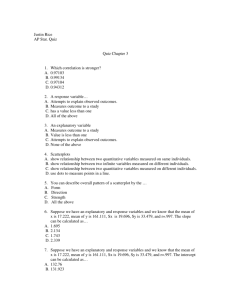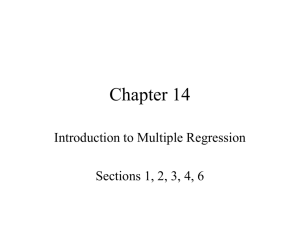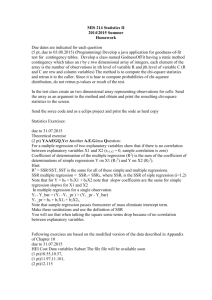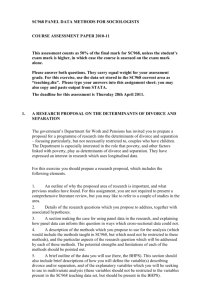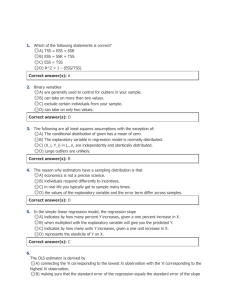PowerPoint slides
advertisement
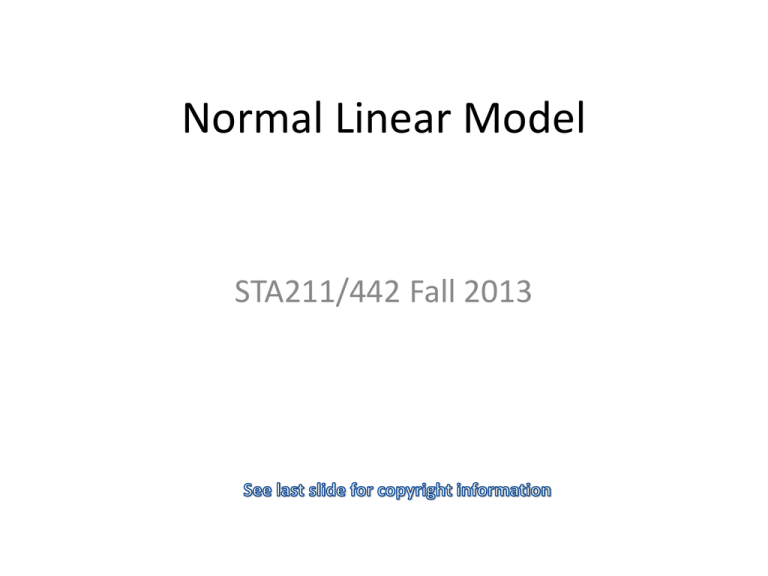
Normal Linear Model
STA211/442 Fall 2013
Suggested Reading
• Davison’s Statistical Models, Chapter 8
• The general mixed linear model is defined in
Section 9.4, where it is first applied.
General Mixed Linear Model
Fixed Effects Linear Regression
“Regression” Line
Regression Means Going Back
• Francis Galton (1822-1911) studied
“Hereditary Genius” (1869) and other traits
• Heights of fathers and sons
– Sons of the tallest fathers tended to be taller than
average, but shorter than their fathers
– Sons of the shortest fathers tended to be shorter
than average, but taller than their fathers
• This kind of thing was observed for lots of
traits.
• Galton was deeply concerned about
“regression to mediocrity.”
Measure the same thing twice, with error
Conditional distribution of Y2 given Y1=y1
for a general bivariate normal
• If y1 is above the mean, average y2 will also be
above the mean
• But only a fraction (rho) as far above as y1.
• If y1 is below the mean, average y2 will also be
below the mean
• But only a fraction (rho) as far below as y1.
• This exactly the “regression toward the mean”
that Galton observed.
Regression toward the mean
• Does not imply systematic change over time
• Is a characteristic of the bivariate normal and
other joint distributions
• Can produce very misleading results,
especially in the evaluation of social programs
Regression Artifact
• Measure something important, like performance
in school or blood pressure.
• Select an extreme group, usually those who do
worst on the baseline measure.
• Do something to help them, and measure again.
• If the treatment does nothing, they are expected
to do worse than average, but better than they
did the first time – completely artificial!
A simulation study
• Measure something twice with error: 500
observations
• Select the best 50 and the worst 50
• Do two-sided matched t-tests at alpha = 0.05
• What proportion of the time do the worst 50
show significant average improvement?
• What proportion of the time do the best 50
show significant average deterioration?
Summary
• Source of the term “Regression”
• Regression artifact
– Very serious
– People keep re-inventing the same mistake
– Can’t really blame the policy makers
– At least the statistician should be able to warn
them
– The solution is random assignment
– Taking difference from a baseline measurement
may still be useful
Multiple Linear Regression
Statistical MODEL
• There are p-1 explanatory variables
• For each combination of explanatory
variables, the conditional distribution of
the response variable Y is normal, with
constant variance
• The conditional population mean of Y
depends on the x values, as follows:
Control means hold constant
So β3 is the rate at which E[Y|x] changes as
a function of x3 with all other variables
held constant at fixed levels.
Increase x3 by one unit
holding other variables constant
So β3 is the amount that E[Y|x] changes when
x3 is increased by one unit and all other
variables are held constant at fixed levels.
It’s model-based control
• To “hold x1 constant” at some particular value,
like x1=14, you don’t even need data at that
value.
• Ordinarily, to estimate E(Y|X1=14,X2=x), you
would need a lot of data at X1=14.
• But look:
Statistics b estimate parameters beta
Categorical Explanatory Variables
• X=1 means Drug, X=0 means Placebo
• Population mean is
• For patients getting the drug, mean response is
• For patients getting the placebo, mean response
is
Sample regression coefficients for a
binary explanatory variable
• X=1 means Drug, X=0 means Placebo
• Predicted response is
• For patients getting the drug, predicted response is
• For patients getting the placebo, predicted response is
Regression test of b1
• Same as an independent t-test
• Same as a oneway ANOVA with 2 categories
• Same t, same F, same p-value.
Drug A, Drug B, Placebo
• x1 = 1 if Drug A, Zero otherwise
• x2 = 1 if Drug B, Zero otherwise
•
• Fill in the table
Drug A, Drug B, Placebo
• x1 = 1 if Drug A, Zero otherwise
• x2 = 1 if Drug B, Zero otherwise
•
Regression coefficients are contrasts with the category
that has no indicator – the reference category
Indicator dummy variable coding with
intercept
• Need p-1 indicators to represent a
categorical explanatory variable with p
categories
• If you use p dummy variables, trouble
• Regression coefficients are contrasts with
the category that has no indicator
• Call this the reference category
Now add a quantitative variable
(covariate)
• x1 = Age
• x2 = 1 if Drug A, Zero otherwise
• x3 = 1 if Drug B, Zero otherwise
•
Effect coding
•
•
•
•
p-1 dummy variables for p categories
Include an intercept
Last category gets -1 instead of zero
What do the regression coefficients mean?
Meaning of the regression
coefficients
The grand mean
With effect coding
• Intercept is the Grand Mean
• Regression coefficients are deviations of group
means from the grand mean.
• They are the non-redundant effects.
• Equal population means is equivalent to zero
coefficients for all the dummy variables
• Last category is not a reference category
Add a covariate: Age = x1
Regression coefficients are deviations from the average
conditional population mean (conditional on x1).
So if the regression coefficients for all the dummy
variables equal zero, the categorical explanatory variable
is unrelated to the response variable, controlling for the
covariate(s).
Effect coding is very useful when there is
more than one categorical explanatory
variable and we are interested in interactions
--- ways in which the relationship of an
explanatory variable with the response
variable depends on the value of another
explanatory variable.
Interaction terms correspond to products of
dummy variables.
Analysis of Variance
And testing
Analysis of Variance
• Variation to explain: Total Sum of Squares
• Variation that is still unexplained: Error
Sum of Squares
• Variation that is explained: Regression (or
Model) Sum of Squares
ANOVA Summary Table
Proportion of variation in the
response variable that is explained
by the explanatory variables
Hypothesis Testing
• Overall F test for all the explanatory variables at
once,
• t-tests for each regression coefficient: Controlling
for all the others, does that explanatory variable
matter?
• Test a collection of explanatory variables
controlling for another collection,
• Most general: Testing whether sets of linear
combinations of regression coefficients differ
from specified constants.
Controlling for mother’s education and
father’s education, are (any of) total family
income, assessed value of home and total
market value of all vehicles owned by the
family related to High School GPA?
(A false promise because of measurement error in education)
Full vs. Reduced Model
• You have 2 sets of variables, A and B
• Want to test B controlling for A
• Fit a model with both A and B: Call it the Full
Model
• Fit a model with just A: Call it the Reduced
Model
• It’s a likelihood ratio test (exact)
When you add r more explanatory
variables, R2 can only go up
• By how much? Basis of F test.
• Denominator MSE = SSE/df for full model.
• Anything that reduces MSE of full model increases
F
• Same as testing H0: All betas in set B (there are r
of them) equal zero
General H0: Lβ = h (L is rxp, row rank r)
Distribution theory for tests, confidence
intervals and prediction intervals
Independent chi-squares
Prediction interval
Back to full versus reduced model
F test is based not just on change in R2,
but upon
Increase in explained variation expressed as a fraction
of the variation that the reduced model does not explain.
• For any given sample size, the bigger a is, the
bigger F becomes.
• For any a ≠0, F increases as a function of n.
• So you can get a large F from strong results
and a small sample, or from weak results and
a large sample.
Can express a in terms of F
• Often, scientific journals just report F, numerator df
= r, denominator df = (n-p), and a p-value.
• You can tell if it’s significant, but how strong are the
results? Now you can calculate it.
• This formula is less prone to rounding error than the
one in terms of R-squared values
When you add explanatory variables
to a model (with observational data)
• Statistical significance can appear when it was
not present originally
• Statistical significance that was originally
present can disappear
• Even the signs of the b coefficients can
change, reversing the interpretation of how
their variables are related to the response
variable.
• Technically, omitted variables cause regression
coefficients to be inconsistent.
A few More Points
•
•
•
•
Are the x values really constants?
Experimental versus observational data
Omitted variables
Measurement error in the explanatory
variables
Recall Double Expectation
E{Y} is a constant. E{Y|X} is a random variable, a function of X.
Beta-hat is (conditionally) unbiased
Unbiased unconditionally, too
Perhaps Clearer
Conditional size α test, Critical region A
Why predict a response variable from
an explanatory variable?
• There may be a practical reason for prediction
(buy, make a claim, price of wheat).
• It may be “science.”
Young smokers who buy contraband cigarettes
tend to smoke more.
• What is explanatory variable, response
variable?
Correlation versus causation
• Model is
• It looks like Y is being produced by a
mathematical function of the explanatory
variables plus a piece of random noise.
• And that’s the way people often interpret
their results.
• People who exercise more tend to have better
health.
• Middle aged men who wear hats are more
likely to be bald.
Correlation is not the same as
causation
Confounding variable: A variable
that is associated with both the
explanatory variable and the
response variable, causing a
misleading relationship between
them.
Mozart Effect
• Babies who listen to classical music tend to do better
in school later on.
• Does this mean parents should play classical music
for their babies?
• Please comment. (What is one possible confounding variable?)
Parents’ education
• The question is DOES THIS MEAN. Answer the
question. Expressing an opinion, yes or no
gets a zero unless at least one potential
confounding variable is mentioned.
• It may be that it’s helpful to play classical
music for babies. The point is that this study
does not provide good evidence.
Hypothetical study
• Subjects are babies in an orphanage (maybe in Haiti) awaiting
adoption in Canada. All are assigned to adoptive parents, but
are waiting for the paperwork to clear.
• They all wear headphones 5 hours a day. Randomly assigned
to classical, rock, hip-hop or nature sounds. Same volume.
• Carefully keep experimental condition secret from everyone
• Assess academic progress in JK, SJ, Grade 4.
• Suppose the classical music babies do better in school later
on. What are some potential confounding variables?
Experimental vs. Observational studies
• Observational: Explanatory, response variable just
observed and recorded
• Experimental: Cases randomly assigned to values of
the explanatory variable
• Only a true experimental study can establish a causal
connection between explanatory variable and
response variable.
• Maybe we should talk about observational vs experimental variables.
• Watch it: Confounding variables can creep back in.
If you ignore measurement error in the
explanatory variables
• Disaster if the (true) variable for which you are trying
to control is correlated with the variable you’re trying
to test.
– Inconsistent estimation
– Inflation of Type I error rate
• Worse when there’s a lot of error in the variable(s)
for which you are trying to control.
• Type I error rate can approach one as n increases.
Example
• Even controlling for parents’ education and
income, children from a particular racial group
tend to do worse than average in school.
• Oh really? How did you control for education
and income?
• I did a regression.
• How did you deal with measurement error?
• Huh?
Sometimes it’s not a problem
• Not as serious for experimental studies,
because random assignment erases
correlation between explanatory variables.
• For pure prediction (not for understanding)
standard tools are fine with observational
data.
More about measurement error
• R. J. Carroll et al. (2006) Measurement Error
• in Nonlinear Models
• W. Fuller (1987) Measurement error models.
• P. Gustafson (2004) Measurement error and
misclassification in statistics and epidemiology
Copyright Information
This slide show was prepared by Jerry Brunner, Department of
Statistics, University of Toronto. It is licensed under a Creative
Commons Attribution - ShareAlike 3.0 Unported License. Use
any part of it as you like and share the result freely. These
Powerpoint slides will be available from the course website:
http://www.utstat.toronto.edu/brunner/oldclass/appliedf13
